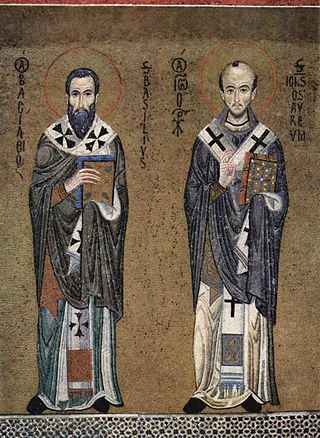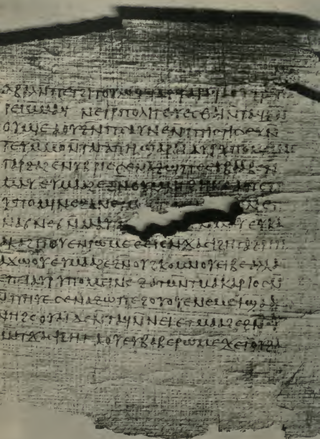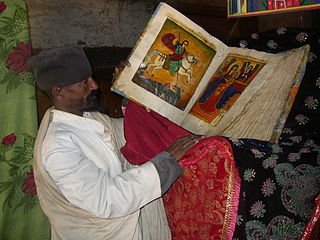
Divine Liturgy or Holy Liturgy is the Eucharistic service of the Byzantine Rite, a liturgical rite developed from the Antiochene Rite of Christian liturgy which is that of the Ecumenical Patriarchate of Constantinople. As such, it is used in the Eastern Orthodox, the Greek Catholic Churches, and the Ukrainian Lutheran Church. Although the same term is sometimes applied in English to the Eucharistic service of Armenian Christians, both of the Armenian Apostolic Church and of the Armenian Catholic Church, they use in their own language a term meaning "holy offering" or "holy sacrifice". Other churches also treat "Divine Liturgy" simply as one of many names that can be used, but it is not their normal term.

The Didache, also known as The Lord's Teaching Through the Twelve Apostles to the Nations, is a brief anonymous early Christian treatise written in Koine Greek, dated by modern scholars to the first or second century AD.
An apostolic see is an episcopal see whose foundation is attributed to one or more of the apostles of Jesus or to one of their close associates. In Catholicism, the phrase "The Apostolic See" when capitalized refers specifically to the See of Rome.
The Apostolic Fathers, also known as the Ante-Nicene Fathers, were core Christian theologians among the Church Fathers who lived in the 1st and 2nd centuries AD who are believed to have personally known some of the Twelve Apostles or to have been significantly influenced by them. Their writings, though widely circulated in early Christianity, were not included in the canon of the New Testament. Many of the writings derive from the same time period and geographical location as other works of early Christian literature which came to be part of the New Testament.

The New Testament apocrypha are a number of writings by early Christians that give accounts of Jesus and his teachings, the nature of God, or the teachings of his apostles and of their lives. Some of these writings were cited as scripture by early Christians, but since the fifth century a widespread consensus has emerged limiting the New Testament to the 27 books of the modern canon. Roman Catholic, Eastern Orthodox, and Protestant churches generally do not view the New Testament apocrypha as part of the Bible.

The Apostolic Canons, also called Apostolic canons, Ecclesiastical Canons of the Same Holy Apostles, or Canons of the Holy Apostles, is a 4th-century Syrian Christian text. It is an Ancient Church Order, a collection of ancient ecclesiastical canons concerning the government and discipline of the Early Christian Church, allegedly written by the Apostles. This text is an appendix to the eighth book of the Apostolic Constitutions. Like the other Ancient Church Orders, the Apostolic Canons uses a pseudepigraphic form.

The Epistle of the Apostles is a work of New Testament apocrypha. Despite its name, it is more a gospel or an apocalypse than an epistle. The work takes the form of an open letter purportedly from the remaining eleven apostles describing key events of the life of Jesus, followed by a dialogue between the resurrected Jesus and the apostles where Jesus reveals apocalyptic secrets of reality and the future. It is 51 chapters long. The epistle was likely written in the 2nd century CE in Koine Greek, but was lost for many centuries. A partial Coptic language manuscript was discovered in 1895, a more complete Ethiopic language manuscript was published in 1913, and a full Coptic-Ethiopic-German edition was published in 1919.
The Apostolic Constitutions or Constitutions of the Holy Apostles is a Christian collection divided into eight books which is classified among the Church Orders, a genre of early Christian literature, that offered authoritative pseudo-apostolic prescriptions on moral conduct, liturgy and Church organization. The work can be dated from 375 to 380 AD. The provenance is usually regarded as Syria, probably Antioch. The author is unknown, although since James Ussher it has often considered to be the author of the letters of Pseudo-Ignatius, perhaps the 4th-century Eunomian bishop Julian of Cilicia.
Testamentum Domini is a Christian treatise which belongs to the genre of the ancient church orders. The work can be dated to about the 5th-century A.D. even if a 4th-century date is sometimes proposed. The provenience is regarded as Syria, even if also Egypt or Asia Minor are possible origins.
The Apostolic Tradition is an early Christian treatise which belongs to the genre of the ancient Church Orders. It has been described to be of "incomparable importance as a source of information about church life and liturgy in the third century".
Didascalia Apostolorum, or just Didascalia, is a Christian legal treatise which belongs to the genre of the Church Orders. It presents itself as being written by the Twelve Apostles at the time of the Council of Jerusalem; however, scholars agree that it was actually a composition of the 3rd century, perhaps around 230 AD.
The Liturgy of Saint Basil or, more formally, the Divine Liturgy of Saint Basil the Great, is a term for several Eastern Christian celebrations of the Divine Liturgy (Eucharist), or at least several anaphoras, which are named after Basil of Caesarea. Two of these liturgies are in common use today: the one used in the Byzantine Rite ten times a year, and the one ordinarily used by the Coptic Church.

There have been many Coptic versions of the Bible, including some of the earliest translations into any language. Several different versions were made in the ancient world, with different editions of the Old and New Testament in five of the dialects of Coptic: Bohairic (northern), Fayyumic, Sahidic (southern), Akhmimic and Mesokemic (middle). Biblical books were translated from the Alexandrian Greek version.
Henry Tattam was a Church of England clergyman and Coptic scholar.
George William Horner (1849–1930) was a British biblical scholar, an editor of the text of the New Testament in the dialects of the Coptic language.
The ancient church orders form a genre of early Christian literature, ranging from 1st to 5th century, which has the purpose of offering authoritative "apostolic" prescriptions on matters of moral conduct, liturgy and Church organization. These texts are extremely important in the study of early liturgy and served as the basis for much ancient ecclesiastical legislation.
The Alexandrine Sinodos is a Christian collection of Church Orders. This collection of earlier texts dates from the 4th or 5th century CE. The provenience is Egypt and it was particularly used in the ancient Coptic and Ethiopian Christianity.
The Verona Palimpsest is a manuscript, dated about the 494 AD, which contains a Christian collection of Church Orders in Latin. The manuscript, which contains many lacunae, is the only source of the Latin version of the Apostolic Tradition.

The Orthodox Tewahedo biblical canon is a version of the Christian Bible used in the two Oriental Orthodox Churches of the Ethiopian and Eritrean traditions: the Ethiopian Orthodox Tewahedo Church and the Eritrean Orthodox Tewahedo Church. At 81 books, it is the largest and most diverse biblical canon in traditional Christendom.

The Liturgy of Saint Cyril is one of the three Anaphoras used at present by the Coptic Catholic Church and the Coptic Orthodox Church and it retains the liturgical peculiarities which have originated in the early Christian Egypt, thus forming the core of the historical Alexandrian Rite. When reference is made to its Greek Byzantine Rite version, this text is usually known as Liturgy of Saint Mark.








